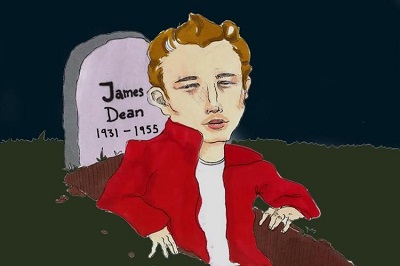|
|
|
|
|
|
Starring From Beyond the Grave

On November 6, Magic City Films announced production of Finding Jack, an upcoming Vietnam War film. That would hardly be worth mentioning, save for the casting of James Dean in a key role. Dean was unavailable for comment because he’s been dead the past 64 years. The filmmakers are treating Dean’s current condition as a mere technicality. They are planning to construct Dean’s “performance” digitally with computer graphics and another actor supplying the voice. Dean might not be alone for very long. CMG Worldwide, which owns rights to Dean’s likeness, merged with a “content creation studio” Worldwide XR, “a new company that aims to bring digital humans to traditional film as well as augmented and virtual reality.” This company now owns the rights to 1,700 deceased celebrities including Burt Reynolds, Christopher Reeve, Ingrid Bergman, Bette Davis and Jack Lemmon. They could all be in play, especially if Finding Jack is successful. At first glance this seems insane, a product of the satirical United Appeal for the Dead, but it’s all too real. Casting includes many varying criteria, but traditionally they have all included being alive. There are thousands of living actors who would likely be eager for a role in an upcoming movie. The Finding Jack filmmakers explained “We searched high and low for the perfect character to portray the role of Rogan, which has some extreme complex character arcs, and after months of research, we decided on James Dean.” Yes, I’m sure that was a thorough search, on par with O.J. Simpson’s ongoing quest to find the real killers (now in its 24th year). The Hollywood Reporter, Variety, and Time magazine would not be writing about the film if it had stuck with only human actors. Let’s call the casting what it is: a PR gimmick. Assuming this film gets made, will anyone watching care about the character, or will they be thinking “That’s something sort of resembling James Dean.”? Of course the Dean “casting” does not come out of nowhere. TV commercials have played around with this for years. I wish I could forget Fred Astaire dancing with a vacuum cleaner. The directors of Oliver Reed in Gladiator, Paul Walker in Furious 7, and Philip Seymour Hoffman in The Hunger Games: Mockingjay, used digital techniques to finish production when these actors died during filming. Superman Returns reconstructed Marlon Brando as Jor-El by modifying unused footage from the 1978 Superman. More recently, Rogue One: A Star Wars Story used digital effects to bring back Peter Cushing as Grad Moff Tarkin 22 years after Cushing’s death. The Rogue One use of Cushing proved polarizing. For some it made sense given how integral his character was to the Star Wars saga, and how iconic Cushing’s performance in the original Star Wars became. To others it seemed ghoulish and the scenes took them out of the movie. There’s a difference though, between Dean and the others I noted. Since Cushing had already played Tarkin, the filmmakers had a human model for how he would talk, look, and react in that specific role. Same for Reed, Walker, Hoffman and Brando. Dean obviously never played a soldier fighting in Vietnam, a war the U.S. was not even fighting yet when he died. Robert De Niro once said that “The talent is in the choices.” Actors make choices in how they build a character, how they say each line, how they react, and how they emote, just to name a few. The choices they make are how the characters they play come alive. The best actors, to paraphrase Sanford Meisner, find truth in imaginary circumstances. The choices are how the actors find that truth. I have no way of knowing how James Dean would play a soldier in the Vietnam War. Neither do you, nor anyone else, including these filmmakers. They can study how Dean looked, how he moved and how he sounded, but they can never put themselves inside his head. If they want to create a digital character for their film, that’s fine. Filmmakers have been doing that for over 25 years. Motion capture, and the technology behind it, has grown by leaps and bounds. Just be honest about it. Don’t insult our intelligence with comments such as “The family views this as his fourth movie, a movie he never got to make”. James Dean is not acting in this new film. A computer program of something looking somewhat like Dean will appear. That’s it. Beyond the question of honesty comes the question of Dean’s legacy, and those of the others that may be treated this same way. Pictures of some of these celebrities are everywhere, but that’s just an image, the surface. Pretending that we can recreate these actors’ performances cheapens who they were, the human qualities that made them unique. If these were people whose essence could so easily be replicated they would not have been stars in the first place. James Dean was once a struggling young actor. He performed in small roles on TV and was just starting on Broadway when Elia Kazan saw something in him. Kazan took a big chance casting Dean in East of Eden. Dean’s look, rebellious spirit, but most of all his talent made him a star. The best way to honor Dean would not be a hollow copy of him. It would be taking a chance on another actor, maybe even an unknown, who could become a unique star of his own. Adam Spector December 1, 2019 Contact us: |
|
